Book One:
A SIMPLE ACT OF KINDNESS
|
CHAPTER TWENTY-THREE:
THE MAN WHO
SAVED GALVESTON
Written by Rick Archer
©
2015, Richard Archer
|
|
SUBCHAPTER 102 -
THE REASON I
WROTE MY BOOK
|
Rick Archer's Note:
We have
now reached the final section of my book. The
previous chapter involving Vicky and the ghost of my
dog Terry marks the conclusion of my early years
saga. However, the story of Vicky and Terry is
by no means the end of my book.
Ordinarily one writes their memoirs in a timely
fashion. Not in my case. Half a century
has elapsed between the events and the actual
writing of this book. A gap of fifty years is
a considerable amount of time. Not
surprisingly, with the passage of time, there were
new developments that shed considerable light on the
events of yesteryear.
It
should be obvious by now that Mrs. Ballantyne is the
centerpiece of my story. Given the fact that I
spoke to Mrs. Ballantyne one time in my entire nine
years at St. John's, perhaps my fixation on this
lady remains a mystery to the reader. Please
let me explain.
For
starters, Mrs. Ballantyne's timely intervention into
my troubled life was indeed the Simple Act of
Kindness that inspired the title for this
book. However, it wasn't just Mrs.
Ballantyne's kindness that caught my attention.
There was more.
In the
Introduction
of this book, I wrote about the uncanny coincidences
involving the Church Choir in Beatrice, Nebraska.
To me, the coincidences involving my chance meeting
with Mrs. Ballantyne were just as unlikely as the
coincidences involving the Church Choir. I
can't say it any other way... the utter
improbability of the coincidences surrounding my
1968 parking lot event was difficult to accept.
Up to
this point in my life, I had not been particularly
religious. I suppose if that parking lot
meeting was the only strange thing that ever
happened to me, I would have brushed it off just
like most people do with their own coincidences.
But there were more coincidences after that.
Many more. Each coincidence by itself didn't
amount to much, but they started to add up.
Something fishy was going on in my life, I was sure
of it. After a while, I just couldn't accept
the rational explanations anymore. Nothing
seemed to make sense using accepted scientific
explanations. To me, the odds were just too
great.
During
my Freshman year of college, I was far too busy to
think about the incident. However that all
changed in March 1970 during my Sophomore year in
college. One night I listened to a lecture
given by a self-described mystic named Bob
Hieronimus. His lecture interested me enough
to begin reading about Edgar Cayce, the American
mystic. Now I was getting very curious.
That led to further reading. At one point, I
ran across a powerful quote.
"The more frequently one uses the word
‘Coincidence’ to explain bizarre happenings, the
more obvious it becomes that
one is not seeking, but rather evading the real explanation."
-- Robert Shea & Robert Anton Wilson.
My mind immediately raced to the event involving
Mrs. Ballantyne. NOTHING could have been more
bizarre than that meeting.
This
quote encouraged me to look at the world in a new
way. Was there a possibility that Mrs. Ballantyne
had been guided to my side by an unseen hand??
To me, that explanation made more sense than all the
scientific explanations.
Deep
down, it felt to me like Mrs. Ballantyne had shown
up at that grocery store for a reason. The
coincidence of her sudden appearance was
overwhelming. From the moment we met, Mrs.
Ballantyne went right to work. Our ensuing
conversation became a pivotal moment in my life (Chapter
16).
My
memory of the parking lot coincidences helped me
become open-minded about alternative explanations
for "coincidences". That intensified my
search. After reading books on the occult,
mysticism, ESP, Eastern religion, and Jungian
synchronicity, I warmed up to the idea that the
hidden world suggested in these books might actually
exist. Perhaps there really was more to this
world than meets the eye.
I began
to view my meeting with Mrs. Ballantyne as a
potential religious experience. However, that
didn't mean my mind was made up. To me, that
chance meeting was hardly definitive proof that God
exists. In my Junior year of college I took a
course in the Philosophy of Religion
at Johns Hopkins. My professor was especially
fond of one term...
agnosticism.
Agnosticism is the view that the
truth of certain claims –
especially metaphysical and religious claims
such as whether or not God, the divine or the
supernatural exist – are unknown and
perhaps unknowable.
One afternoon after class Professor Jenkins and I
discussed the parking lot meeting at length.
Then I told him about "The Ghost of Terry" incident
(Chapter 22).
At the end, Dr. Jenkins smiled and said, "Your two
stories are very interesting, Rick. If people
are willing to listen, you may offer these
experiences as testimony. However, it is
impossible to prove the existence of God to a
skeptic through mere words. Ultimately, the
existence of God is a question every man decides for
himself."
I
completely agreed with what Dr. Jenkins said.
The problem with a religious experience is that it
defies explanation... even to myself!! Just
because I wanted to believe I had a religious
experience with Mrs. Ballantyne was not enough
reason to make a firm conclusion. After all, I
had no idea what "really" took place in the parking
lot that day or at the séance when Terry appeared.
.
Now I
had two supernatural experiences to think about.
The 1968 event with Mrs. Ballantyne started this
chain of events. Then came the remarkable 1970
séance experience. At this point my remaining
skepticism about the existence of an Unseen World
melted away. The event with Vicky led me to
conclude that the mystical principles such as
Reincarnation, Fate, and Karma were a real
possibility.
Please
note I said 'possibility'. There is always an
element of doubt in my mind. That said, I was
now a 90% Believer.
The
incident with Vicky and Terry was an important
moment in my life because now I dedicated the rest
of my life to searching for further evidence to
support the claim of an Unseen World. From
that point on, I examined every unusual thing that
happened to me from two perspectives... a 'realistic'
point of view and a 'mystic' point of
view. Any time there was a coincidence,
I raised an eyebrow. As my life progressed, I
became more and more convinced I was onto something.
I began to believe that some things happen for a
reason... even if I did not understand a damn thing
about 'why' these things happen to me.
I am
getting ahead of myself here, but there were several
fortunate coincidences in 1977-1978 that led to the
start of my dance career. Somebody in high
places clearly wanted me to succeed because I was
being handed one huge break after another.
When placed side by side, this sequence of events
was so convenient that I became deeply suspicious.
Once I began to connect the dots, these events would
strike me as pure Destiny, which of
course is the title of my sequel to this book.
We
already know that despite my litany of handicaps, I
would one day create the largest dance studio in
America. Not bad for a guy who couldn't even
dance. Given my extraordinary limitations, the
fact that my dance studio was wildly successful
became further proof that there was more to this
world than meets the eye. I had no business
owning a dance studio... unless, of course, it
was meant to be.
The
truth of the matter is that I feel awkward talking
about God given that I have no direct experience of
His existence.
That
said, I do believe I possess strong INDIRECT
EVIDENCE of His existence.
Based on
the coincidences I have observed, I believe there is
a strong possibility our lives are guided by a
higher power. I also believe it is my duty to
share this indirect evidence. Therefore
I decided to write this book as testimony to the
unusual events of my life.
No doubt
there are many others who are just as curious about
the mysteries of Life as me. By sharing my
personal story, it is my hope that my modest
contribution will resonate with other travelers on
the Path.
|
|
|
SUBCHAPTER 103
-
THE GREAT
STORM
|
| |
Rick's Note: I
have a favor to ask. I am about to tell the
story of the man who saved Galveston. I
have my reasons for telling this story, but I prefer
to keep them a secret for a while. I am saving a
surprise that will surely make
you smile. I think
this is a fascinating story. I hope you enjoy
reading
it as much as I did writing it.
|
| |
| |
Galveston
was
originally inhabited by Indians, then
pirates, then Spanish, and finally the
settlers who would become the Texans.
Following Texas
Independence
in 1836, a group of entrepreneurs
discovered the value of
Galveston's
world-class deep-water port.
Throughout the 1800s, Galveston and Houston
were locked in a bitter economic rivalry.
Galveston was definitely well out in front.
This port was an
unparalleled economic engine that created
great wealth and prosperity for
everyone on the
Island. By
the mid to late Nineteenth Century,
Galveston was one of the richest cities in
the world on a per capita basis!
Galveston was an
island port and trading center that was very
much as busy as
Hong Kong.
Huge southern
mansions lined Broadway
and grand houses were
scattered throughout the neighborhoods.
In addition,
the middle class and the
working class
enjoyed a very high
standard of living.
Cooled
by balmy ocean breezes, Galveston was a
paradise.
|
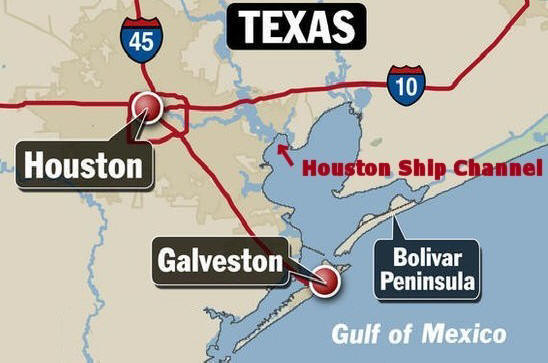 |
And then the Great Storm hit in 1900...
The people of Galveston never knew it was
coming.
By the time they found out,
it was too late.
There was no escape.
1 in
every 4 died.
|
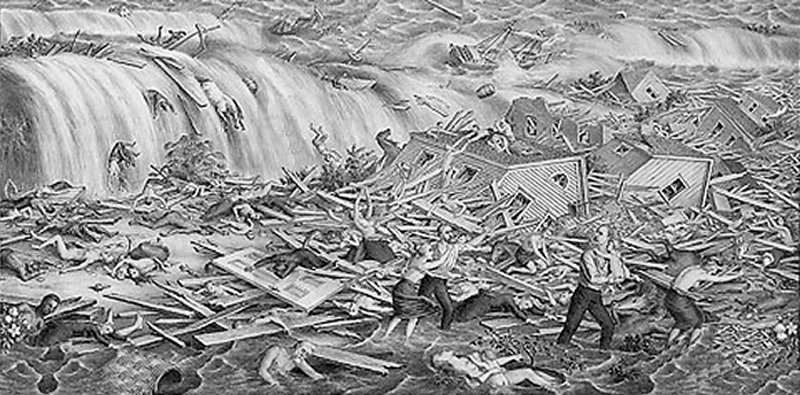 |
|
|
|
|
Strangely enough, the worst disaster in
American history was never given a name.
To this day, they simply call it "The Great
Storm".
As one might gather, Galveston had been
debating the wisdom of building a seawall
throughout the latter part of the 1800s.
"Within the last two or three years,
people have begun to think that the
islands and peninsulas along the Texas
and Louisiana Coast
are unsafe places to inhabit due to the threat of
hurricane. Galveston
Island is but a waif of the ocean,
liable at any moment
to be engulfed
and submerged by the self-same power
that gave it form." -- Braman's
Information about Texas, 1858
However, like many things in
life, the soothsayers were unable to capture
the attention of the townspeople until it
was too late.
|
Many are surprised to learn that the
highest death total from a disaster in
America history was this deadly Galveston
hurricane.
Somewhere between 6,000 and 12,000 people
lost their lives that day. By
comparison, famous disasters such as the San
Francisco earthquake (3,000), 9-11 (3,000), Pearl Harbor (2,500), and Hurricane
Katrina (2,000) don't even come close.
Sadly, the citizens had no idea the
hurricane was coming. They were
completely blind-sided. Given the fact
that only a single narrow bridge connected
Galveston to the mainland, the people had no
way to escape. Nor was there any
refuge. The city was defenseless. The wood structures were
simply not strong enough. With no high spots to retreat
to, once their house fell, they were goners. With no
protection from the incoming flood waters,
a 15-foot storm surge inundated the city. Structures were
flattened and many helpless victims drowned.
The Great Storm became the defining event in
Galveston history. The ocean cleared
the land of all structures on the Gulf of
Mexico side of the island. A strip
extending the full length of the city and
approximately eleven blocks deep was
flattened. Approximately 4,000
structures were demolished. Only one
third of the buildings still stood in the
aftermath of the
storm.
Throughout the 1800s, Galveston had been the
largest, most prosperous city in Texas.
A major center of commerce, with a
population of 38,000 at the turn of the
century, Galveston had been poised for greatness.
That was all gone.
In the blink of an eyelash, the city had
been reduced to rubble. Overnight the
population went from 38,000 to 30,000.
Then after many of survivors moved away, it
went to 25,000.
|
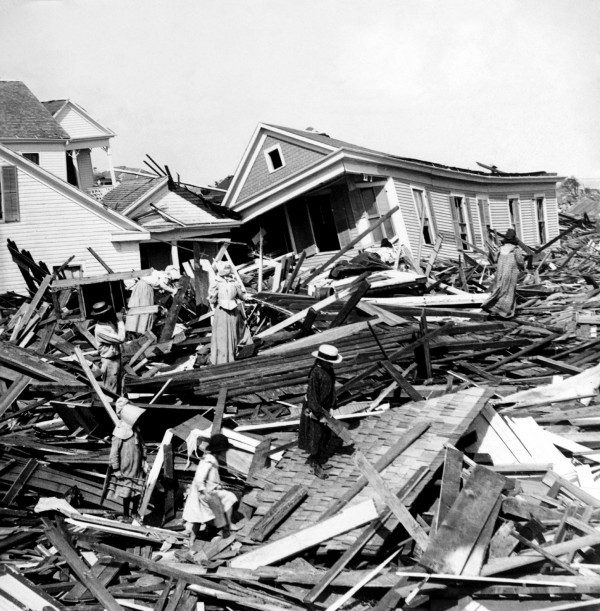 |
|
|
By some accounts Galveston didn't even exist
anymore.
Rebuilding would take a long
time. First came the seawall, the project the
city had been delaying for years.
The vote to build the seawall passed with
little opposition.
Gaining a consensus
on the seawall no longer seemed to be an issue.
Someone with a dark sense of humor said all
the voters who had previously disagreed must
be dead now.
In addition to the
massive seawall to buffer the Gulf of Mexico
from Galveston, in addition they
also raised the grade of the downtown
part of the city several feet higher than
before. If water did get over the
seawall, it would drain much more quickly.
By all standards, Galveston had been well
ahead of Houston at the turn of the century.
Located just 50 miles apart, Galveston's
population was 38,000, Houston's population
was 44,000. However, Galveston's
population was growing and Houston's wasn't.
Galveston's buildings were far more
attractive and the city was actually larger
in size. Meanwhile Houston was a
dirty, unimpressive ramshackle town that
existed primarily as a place for railroads
to export lumber and cotton. Much of
Houston's exports went directly to Galveston
from where it was shipped to other parts of
the country. In other words, Houston
was supported by Galveston's booming
economy.
On September 8th, 1900, that all
changed. The unnamed hurricane marked the turning
point in the fortunes of the two cities.
Galveston's leaders soon got a new piece of
bad news. Instead of investors rushing
in to rebuild Galveston, they stayed away in
droves. After the storm, investors were
afraid of Galveston's vulnerable location.
They preferred to invest in Houston instead.
This was just the beginning.
Galveston's string of bad luck wasn't over.
Not by a long shot.
In January 1901... just four short months
after the hurricane... the
famous Spindletop oil discovery in nearby
Beaumont not only changed the face of Texas,
but the entire United States as well.
No oil field in the world had ever been so
productive. Thanks to Texas, the
United States became the world's leading oil
producer at the time. Furthermore,
Texas wasn't done yet. Spindletop
generated a frenzy of further oil
exploration throughout the State. The ensuing economic development became known as the
Texas Oil Boom.
Spindletop presented a huge opportunity at
the exact moment when Galveston was unable to respond.
Although Galveston possessed the finest
natural port in the entire South, it was unable to invest in the
burgeoning oil industry because most of its
capital was tied up in developing the seawall defense
against future disasters.
No one ever
said that life was fair.
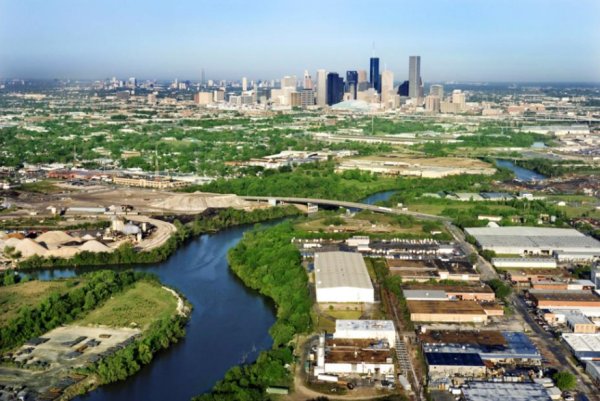
The Houston Ship
Channel flows practically
to the edge of Houston's gleaming towers
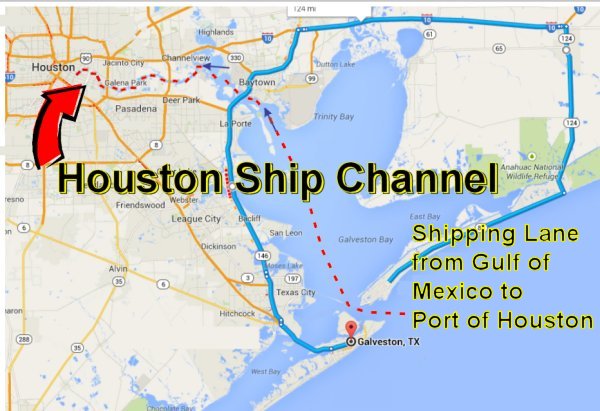
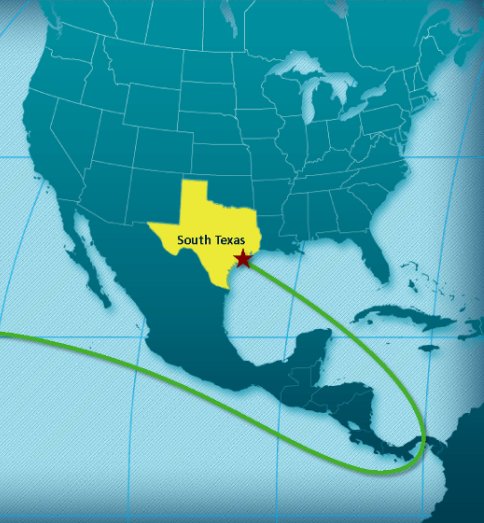 |
The man who compounded Galveston's misery
arrived in Houston in 1898.
His name was Jesse H. Jones.
(Yes, this was the same Jesse H. Jones who
created the Jones Scholarship that caused me
so much anguish in my Senior year of high
school.)
Jesse H. Jones was Houston's original mover
and shaker. A builder and investor,
Jones had just begun to make his mark when
the Great Storm and Spindletop took place.
Jones took careful
note of the Spindletop oil discovery.
He anticipated that the oil strike plus the
growing importance of rice crops would create a
rapid shift in the economy in Texas.
Sensing that
Houston was perfectly poised to take
advantage,
Jesse Jones began building the city that
would accommodate the explosive growth of
the new Texas economy. Houston
business leaders agreed. Houston
began its rise to prominence.
With Galveston crippled by the hurricane,
Spindletop shifted the region’s development from Galveston to Houston.
Galveston was reeling and Jesse H. Jones supplied the kill shot.
Jones proposed building the
Houston Ship Channel!!
It was a brilliant move. Galveston was
by far the superior port and much more
convenient to shipping in the Gulf of
Mexico. But Galveston was crippled and
unable to make a counter-move.
Galveston officials stared glumly as
Houston dredged out Buffalo Bayou.
The engineers created an artificial
canal wide enough and deep enough to
serve gigantic oil tankers.
Even more
ironic, the Houston Ship Channel
extended practically to the edge of
downtown Houston. Now smug
executives in their tall skyscrapers
could look out and survey their
growing empire.
Houston was
no longer dependent on Galveston's port. This new ship channel was not only protected
from the ocean, it was better positioned
geographically to build new rail and roads
for shipping than Galveston Island would
have been.
The opening of the Ship Channel made
Houston an International port
overnight. Oil, rice,
and cotton came straight to Houston
shipyards and was redirected to
distant ports. Galveston's share of
Houston's economy evaporated
overnight.
Jesse Jones was not only a shrewd
anticipator of economic trends, he also
possessed
uncanny good luck and timing.
Just months before the Ship Channel was
completed in 1914, the Panama Canal opened.
Ordinarily Galveston, the superior natural
deepwater seaport, would have been poised to
take advantage. But they were still too busy
building their seawall. Houston
became the obvious next choice as the
first stop for all sea traffic to and from
the Panama Canal.
The Panama
Canal could have been
Hong Kong to Galveston.
Instead it was Hong Kong to Houston.
Jesse Jones' lucky streak continued when
World War I broke out in 1914. World
War I was highly mechanized. This
created an overwhelming thirst for more oil that could only be
met from one place on earth - Houston, Texas.
Thanks to the
Houston Ship Channel,
World War I and the Panama Canal propelled
Houston into world prominence. Houston
not only became the dominant seaport
in the South, this marked the
beginning of Houston's evolution into the
nation’s petrochemical capital.
Since Houston
is my hometown, from my point
of view, I say thank
you, Jesse Jones, for your foresight... even
if I didn't win your college scholarship.
But my heart
certainly goes out to Galveston.
|
|
|
|
Houston's gain was Galveston's loss.
Unfortunately, once the seawall was
completed 1915, it was too late for
Galveston.
Alarmed at the city's terrible run of bad
luck, the civic leaders decided that tourism
was their best bet to make a comeback.
For starters, the new seawall helped create a
very beautiful beach right in front of
the city. Why not put a hotel
there?
In 1911, the Hotel Galvez was completed.
Unfortunately, the city's economy was still
in dry dock. Despite the beautiful
hotel and the convenient beach, there was no
rush to fill the Galvez.
Strangely, the event that got Galveston
moving again was the Prohibition Era
(1920-1933). In hindsight, we now know
that a major unintended consequence of
Prohibition was the growth of urban crime
organizations... Al Capone, for example.
Into Galveston's economic vacuum came Sam
Maceo. Referred to as the 'Galveston
Godfather' and 'Mr. Galveston',
Maceo
soon became the
most important man in the history of Galveston.
|
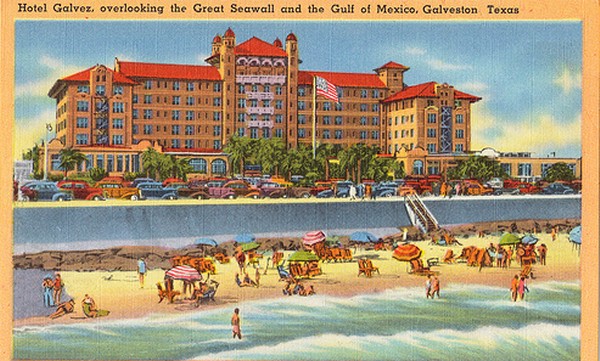 |
|
|
SUBCHAPTER 104
-
SAM MACEO
|
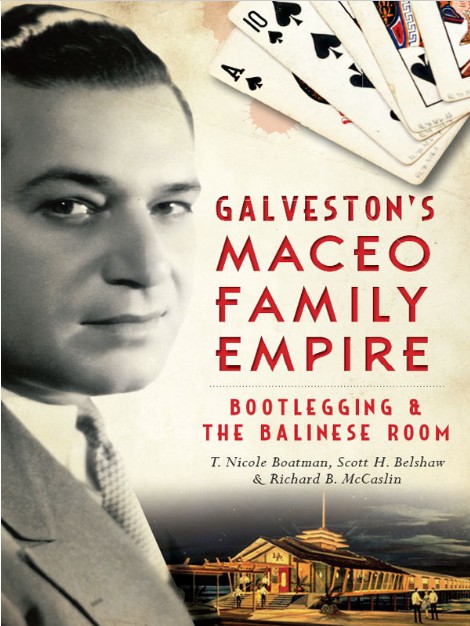 |
Sam Maceo
and his brother Rosario came to
Galveston shortly before the outbreak of
World War I. They were barbers by
trade.
As
Prohibition took hold, the brothers began to
smuggle in cheap wine to give as gifts to
their customers. Seeing how interested their customers
were in the liquor supply, the Maceos
gradually became serious bootleggers.
The Maceo brothers allied themselves with Beach
Gang leader Ollie Quinn and opened the
Hollywood Dinner Club, the Gulf
Coast's most
elegant night club.
Sam
Maceo's smooth personality quickly made him
the face of the nightclub. It was during
this time that Maceo developed his style and
the
interpersonal skills that would come in
handy when dealing with Island politicians.
In short order, Maceo learned the name of
every person on the island and Galveston County.
Apparently those political skills paid off
handsomely...
fortuitous arrests of the leaders of the
other existing
gangs allowed the brothers to gain complete
control of the island's underworld without
any sort of blood bath.
Sam
Maceo operated more like a clever politician than a gangster. Known as the "Velvet Glove," Maceo's smooth style and ability to
influence people was legendary. Through his vast network of
connections, Maceo wielded influence
comparable to an elected official and a business leader at the same
time.
Sam
Maceo held relationships with
celebrities and politicians throughout Texas and the United States. Thanks in large part to his own substantial celebrity and good
deeds, law enforcement found it easier to look the other way.
Once Sam Maceo was in control, through gambling, prostitution and nightclubs, he
built an empire. However, unlike the Brando character in the
Godfather, Sam Maceo was not
known for his use of force.
Since Maceo was allowed to rule Galveston without interference, he
always preferred
to use persuasion in lieu of force.
There were no widespread vendettas in Galveston.
|
During the Twenties
and Thirties, Sam Maceo turned Galveston
into the 'Sin City of the Gulf Coast'.
Modern people refer to Galveston as the
Las Vegas of the Thirties. As
we will see, this phrasing is highly ironic.
Galveston had long been a hot spot for
prostitution dating back to its origins as a
pirate hangout. Indeed, legend has it
that Texas owed a large debt of gratitude to
prostitution... or to a
beautiful prostitute from Galveston in
particular. This former slave girl
would come to be known as "The Yellow Rose of
Texas" due to her mulatto
light-brown coloring.
The Yellow Rose caught the eye of none
other than Generalissimo Santa Ana during
his
visit to a Galveston brothel following
his brutal victory at the Alamo.
Taking the girl with him to his campground at
nearby San Jacinto, the Yellow Rose so
thoroughly distracted Santa Ana that he
failed to make sure the grounds were
properly guarded. The following
morning, the Texas army under General Sam
Houston totally surprised the flat-footed
Mexicans. The fight lasted just 18
minutes. In that brief time, 600
Mexican soldiers were killed and 730
captured. By contrast, only nine
Texans died.
Texas had its independence and the nearby
community got its name... Houston.
Was it Texan fighting superiority or the
charms of this desirable woman that created Texas
Independence? The success of the
Yellow Rose in disarming the enemy might
indeed explain the state's notorious benign
attitude towards women of the night. Perhaps this ancient
debt to the benefits of prostitution explains why
Texas
showed considerable disinterest when it came
to enforcing Texas prostitution laws down in
Galveston.
Since gambling and bootleg liquor went
hand-in-hand with prostitution, the
back rooms of popular nightclubs along the
Galveston seawall became known for their
illegal activities. People from across
the state and nearby Louisiana flocked in.
In addition, all those new Houston
millionaires made sure to buy a pleasure
palace in the Galveston area to accommodate
their frequent visits. In this way,
at least some of that new-found Houston money made
its way back into the Galveston economy.
Meanwhile, for some strange reason, the rest
of the state seemed content to let Galveston
conveniently ignore the vice laws. The
city became known as the 'Free
State of Galveston'. My guess
is that most Texas politicians didn't like
Prohibition any more than the next guy and
enjoyed having a place where they go to have
some fun.
Sam Maceo became the talk of the town.
Thanks to the prosperity generated by
Maceo's empire of decadence, the Twenties
and Thirties would become the heyday of
Galveston.
|

Hotel Galvez and
Sam Maceo's Balinese Room
|
SUBCHAPTER 105
-
DOWN AT THE
BALINESE
|
Perhaps he was a gangster, but at
heart, Sam Maceo was a businessman.
Over time, the Maceos eventually came to own all the
major vice-oriented businesses on the Island.
In the midst of this era of free living, the
Balinese Room stood out as the
most famous nightclub of all. Built in
1929, the
Balinese, Galveston’s most famous
pleasure pier, was ostensibly a restaurant,
but it was also a well-known casino. With
the restaurant in the front part, the casino
was placed at the very back of the structure
extending far out into the Gulf. The
standing joke said the waiters caught the fish every
night.
Sam Maceo used a well-known real estate
technique known as "location location
location" to ensure his nightclub's
success... he put it right across the street
from the now-successful Hotel Galvez.
Smart move.
Sam Maceo had cultivated a relationship with
William Moody, Galveston's business leader
and owner of the Hotel Galvez. Moody
and Maceo got along just fine. Thanks
to Maceo, Moody's giant hotel stayed packed
with celebrities and guests who flocked to
visit the nation's newest resort town.
Imagine their delight to discover that every
vice known to man was open to all, a major
lure indeed during Prohibition. Galveston
became the
playground of the Southwest,
bigger than New Orleans a few hundred miles
to the east.
Though certainly no saint, Sam Maceo was
definitely civic-minded.
Maceo endeared himself not just to William
Moody, but to all his Galveston neighbors by
sharing his profits throughout the city.
Maceo
helped return prosperity to a community weary
from the hurricane devastation.
No one dared upset the apple cart. The
legitimate businesses on the island
such as banking and hotels were able to
thrive thanks to the illegal
activities. Real estate was booming
thanks to the Houston millionaires buying up
those fancy mansions on Broadway Boulevard.
Galveston was back in business.
Now that Maceo had the tacit support of the
business community, it stands to reason that
the politicians were under his spell as
well. This gave law enforcement yet
another reason to look the other way.
The benevolence of Sam Maceo helped
considerably. Though Sam Maceo was the
island's dominant figure, he never abused
his power. He generally did
not attempt to prevent others from
prospering so long as it did not interfere
with his business. In the view of
many, Sam Maceo had brought Galveston back
from ruin.
|
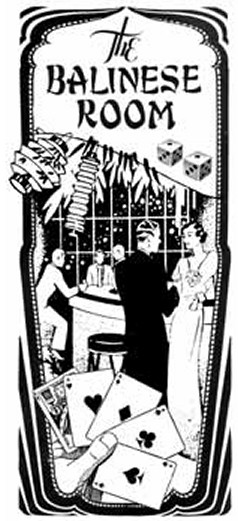 |

If only the walls could talk!! In
the picture above, Sinatra is pleading to Sam Maceo
for help.
|
Frank Sinatra used his mob
connections many times throughout the years to advance
his career. Due to his disastrous love affair with
notorious femme fatale Ava Gardner, Frank
Sinatra's life and career hit rock bottom
in 1950.
Down on his luck and
his career
in deep trouble,
Sinatra was trying to stage a
comeback.
First Sinatra convinced Houston wildcatter Glenn McCarthy
to book him into the Cork Club on top of McCarthy's Shamrock
Hotel down the street from Houston's
Medical Center.
One day, Sinatra
and his friend Jimmy Van Heusen drove
down to Galveston. Van Heusen
was a
composer of many Sinatra hits (e.g. Come Fly With
Me). Now Sinatra pestered crime boss Sam Maceo to book him
following the Shamrock engagement.
Maceo eventually did book
Sinatra to sing at the Balinese Room, but only as the singer
for the house band.
Sinatra's gig at the Balinese played a
large role in his comeback. Within two years, Sinatra's luck
had changed.
Once he was cast in
From Here to Eternity, Sinatra won an
Oscar and never looked back. Some say the story of singer
Johnny Fontane in Godfather I was a thinly
disguised reference to Sinatra.
Meanwhile the Maceo
Galveston operation began to draw
so much heat that they moved their major operations to Las
Vegas, a move reminiscent of scenes from
Godfather Part II.
Although Mario Puzo's Godfather books were supposed to be
fiction, many believe those books didn't require much
imagination to write.
|
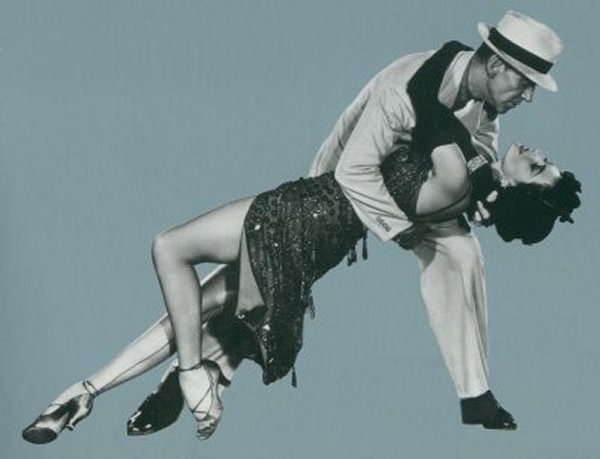
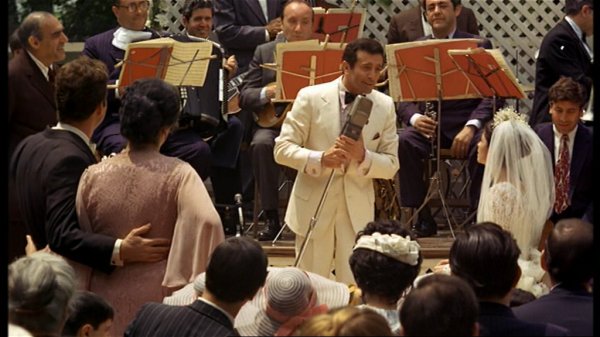 |
|
|
|
SUBCHAPTER 106
-
THE DOWNFALL
OF GALVESTON
|
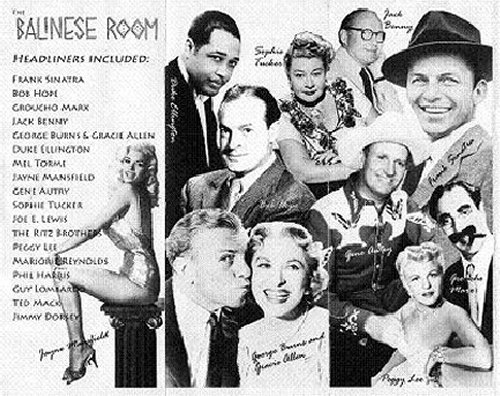 |
Through his considerable skill, Sam Maceo
made the Balinese Room famous throughout the
nation. The
impressive list of entertainers who
performed at his club clearly underscores
the substantial influence of Sam Maceo.
Given the prosperity
he created and his benign approach, Maceo
knew few enemies. This explains how he
was allowed to run vice on the island for
three decades with little opposition.
So what happened to Sam Maceo?
The onset of World War II marked the
beginning of the end.
For one thing, after Pearl Harbor, people weren't exactly in the
mood for partying like they had been.
Then the Hotel Galvez across the street
became headquarters for an expanded Coast
Guard presence to patrol the Gulf of Mexico.
Tourists were forbidden to stay there and
the Balinese Room was declared "off-limits"
for the men barracking at the Galvez.
When World War II was over, Sam Maceo
noticed the political climate had changed.
The Texas Attorney General got elected after
campaigning to “close down Galveston” and
its illegal casinos by using the Texas
Rangers.
|
For thirty years, the laws that applied to
other parts of Texas did not apply to
Galveston. However, after the war,
the open-minded attitudes had
seemingly shifted. Law and Order politicians
from other parts of Texas called upon the
Texas Rangers to look into the Maceo
operation.
The entrance of the Texas Rangers into the
picture brought on a semi-comic cat and
mouse game. Everyone knew the casino
was operating in violation of the law and
that the club’s illegal gambling made it a
hub of mob activity. The problem was
catching them in the act.
The Rangers set up shop in a hotel near the
club and raided the casino often. But their
efforts were thwarted by the length of the
pier. First the band would strike up
the song The Eyes of Texas
upon their arrival. This alerted the dealers
and waitresses to start a
well-rehearsed cover-up. By the time
the Rangers ran down to the tail end of the
long corridor, tables, cards and chips had
all disappeared into secret wall and floor
pockets.
The Rangers did eventually shut the club
down. What was their secret?
First they
gave up trying to catch anyone.
Instead they sat in the casino all day, every
day. Intimidated by the Rangers’
presence, the customers stopped coming.
The Balinese went out of business in 1957.
However, Sam Maceo was long gone by this
time.
As the investigation
into Maceo's Texas activities grew more serious in the late Forties, Maceo
decided he was fed up with the interference.
Frustrated by
the constant need to keep his extensive gambling activities
under wraps, Maceo turned his eyes elsewhere.
At this point Maceo decided to move his empire to Nevada.
He became a major player in a new venture known as "Las Vegas".
Maceo became the
leading investor in the
Desert Inn, a new casino which opened in 1950. At the time, the
Desert Inn was the largest and most elaborate casino resort on
the Las Vegas Strip.
Galveston's loss turned into immense good
fortune for Las Vegas.
Back in
Sam Maceo's hey day, Las Vegas didn't even
have a paved road running through. The
only reason people stopped there was to get
gas on the way to someplace else.
Sam Maceo once
said that if
Texas would just legalize gambling, he could have made Galveston bigger
than Havana, Cuba.
Had
that happened, Las Vegas probably would
never have gotten off the ground because the
mob money would have gone to the
lucrative resort playground already
established in
Galveston.
However, despite his best efforts, Maceo
was never able to find a way to get gambling
legalized in Texas.
One can
only wonder what Galveston would be like
today if Sam Maceo had gotten his way.
On
second thought, maybe we don't have to
wonder. Houston could have been the
next door neighbor to the biggest resort
center in the country.
|
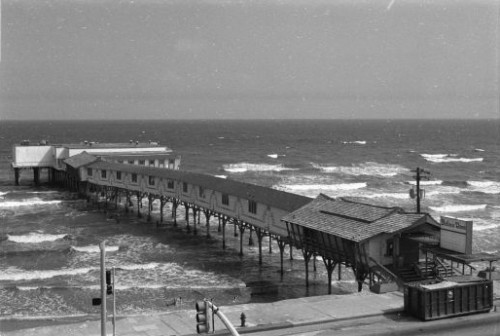
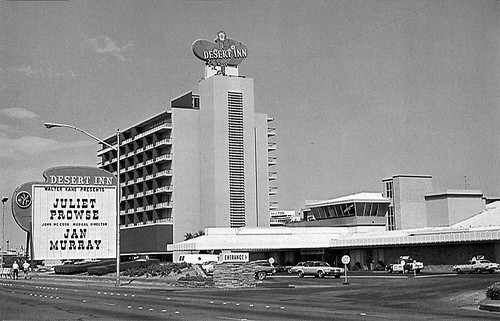
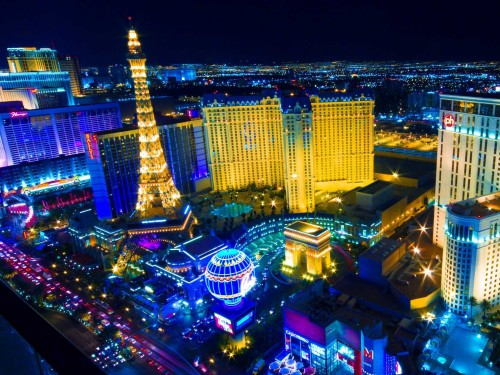 |
|
|
Some people say the
day Sam Maceo left town was as bad as the day the Great Storm
arrived. Once the Maceo Magic left, things were never the same. While Vegas became
a boom town, Galveston became a ghost town.
Law enforcement
bragged that they had rid Galveston of organized crime.
What a joke. In a deeply ironic
twist, during the 1950s far more dangerous criminal elements
entered the vacuum created by Maceo's departure. Taking
advantage of Galveston's history of lax law enforcement, now drugs,
murder, theft and vandalism abounded.
Overnight the magnitude of
the loss of Sam Maceo became more apparent. As they
say, be careful what you wish for. All along Galveston had
thought it had a serious crime problem, but now that Sam Maceo
was gone,
they learned what real crime was.
The closing of the
Balinese in the mid-Fifties marked the end of an era.
Prostitution had been eliminated. Forty-seven clubs,
brothels, and other vice establishments were reportedly closed
and 2,000 slot machines were destroyed. Though officials
said they destroyed all of the city's gaming equipment, most of
the equipment had simply been shipped to Las Vegas before the authorities
ever discovered it. Either way, it didn't matter.
Tourism was completely gone . The hotels were empty and were
soon put up for sale. No one bought them.
The outside forces
that killed the Golden Goose brought difficult
economic times to
the city in the 60s and 70s.
Galveston began a steep decline
into urban decay.
With little activity at
the Port and tourism mostly limited to
day trippers from Houston heading to
the beach, economic activity remained
anemic for the next thirty years.
In many ways, the
loss of Sam Maceo was as bad as the Great Storm had been. The population
declined rapidly as people moved to Houston and elsewhere in
search of employment. With a greatly diminished tax base,
services were curtailed.
This led to another serious
problem. Now the beach became ugly. Seaweed and dead
fish were left to rot in the hot sun. The place smelled.
Litter wasn't being picked up regularly. Poor police
presence allowed low-lifes to make the beach unpleasant for
families to visit. Gangs moved in. As rumors of the
deserted, uncared-for beach made their way through the Greater
Houston area, fewer people bothered to make the trip down.
Another blow came
when Houston's millionaires lost interest in the beautiful old
homes of Galveston. Once the area's popularity was gone,
they sold the old homes for pennies on the dollar.
This left hundreds of magnificent old
buildings to rot and fall apart.
Slowly but surely these magnificent Victorian style homes were
slipping towards the point of no return.
Residents were
appalled by the crumbling historical infrastructure.
All vestiges of Galveston's great past were on the edge of
disappearing. Galveston was on the verge of losing its
ghosts as well. The joke was that Galveston was so dead
even the ghosts in the famous Tremont Hotel were leaving too.
|
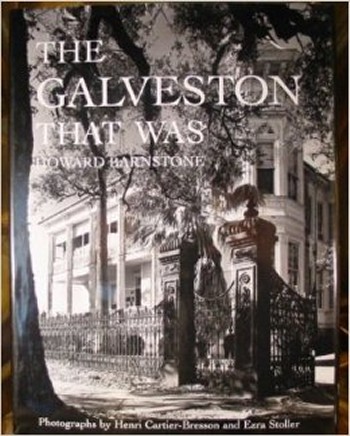
This well-regarded book by Howard
Barnstone
contains many photographs of the old homes.
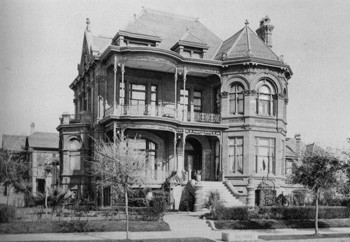
Beautiful Victorian mansions such as this
were abandoned and allowed to decay. |
|
|
SUBCHAPTER 107
-
THE MAN WHO
SAVED GALVESTON
|
Rick Archer's Note: Fortunately for Galveston, starting in the
mid-Seventies, a native son turned his
attention back to his hometown.
Houston oilman
George P. Mitchell began to singlehandedly lift Galveston
onto his back and return Galveston to
prosperity.
The story of what George Mitchell did is so
incredibly profound that I felt absolutely
compelled to add him to my story.
And what exactly is George Mitchell's link to my
story?
Mrs. Ballantyne's
maiden name was Mitchell. Her brother was billionaire
George Mitchell.
Mrs. Ballantyne saved me and her brother
saved Galveston.
That's my surprise.
|
|
|
What is fascinating about George Mitchell is
that both he and his sister Maria grew up poor.
There was no silver spoon in their family.
George Mitchell earned every dime through
sheer genius and hard work.
Along the
way, George Mitchell created energy
independence for America, founded The
Woodlands, saved Galveston, and brought the
cruise industry to Texas for good measure.
George and his wife Cynthia Woods Mitchell
committed themselves to the overall success
and revitalization of The Strand District and
the hotels of Galveston Island.
Over a period of 30
years, the Mitchells invested more than $175
million in rehabilitating historic
properties in The Strand National Historic
Landmark District.
Today Mitchell Historic Properties oversees
Galveston properties owned by George
Mitchell and his family.
These
properties include three hotels - Tremont,
Galvez, Harbor House - and approximately
one-fourth of the buildings in the historic
Strand District and Pier 21 along the
harbor.
From what I gather, two of George and
Cynthia's children - Grant and Sheridan -
are actively involved in overseeing the
continued success of the work of their
parents. Their gesture surely honored
their parents. I imagine this act
touched their father and mother in a
profound way.
It is impossible for me to describe all the
ways that George Mitchell affected
Galveston, but the pictorial tribute below is a
good place to start.
|
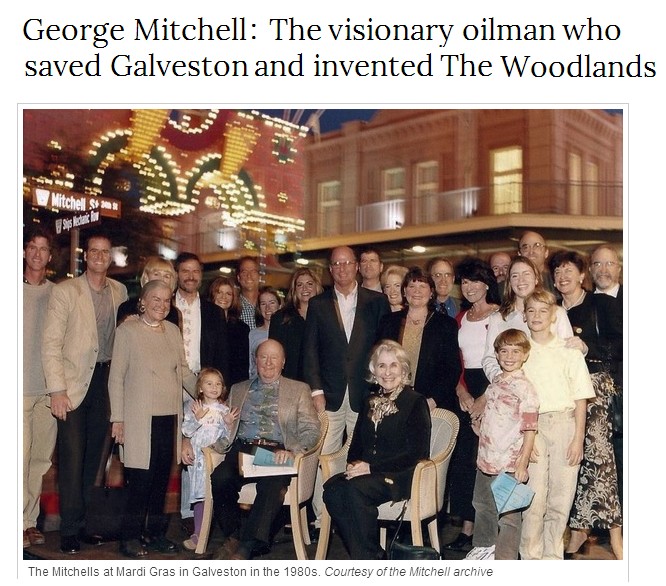
George Mitchell is seated
with his wife Cynthia Woods Mitchell beside
him.
The lady standing with her granddaughter beside
George Mitchell
is
Maria Mitchell Ballantyne.
|
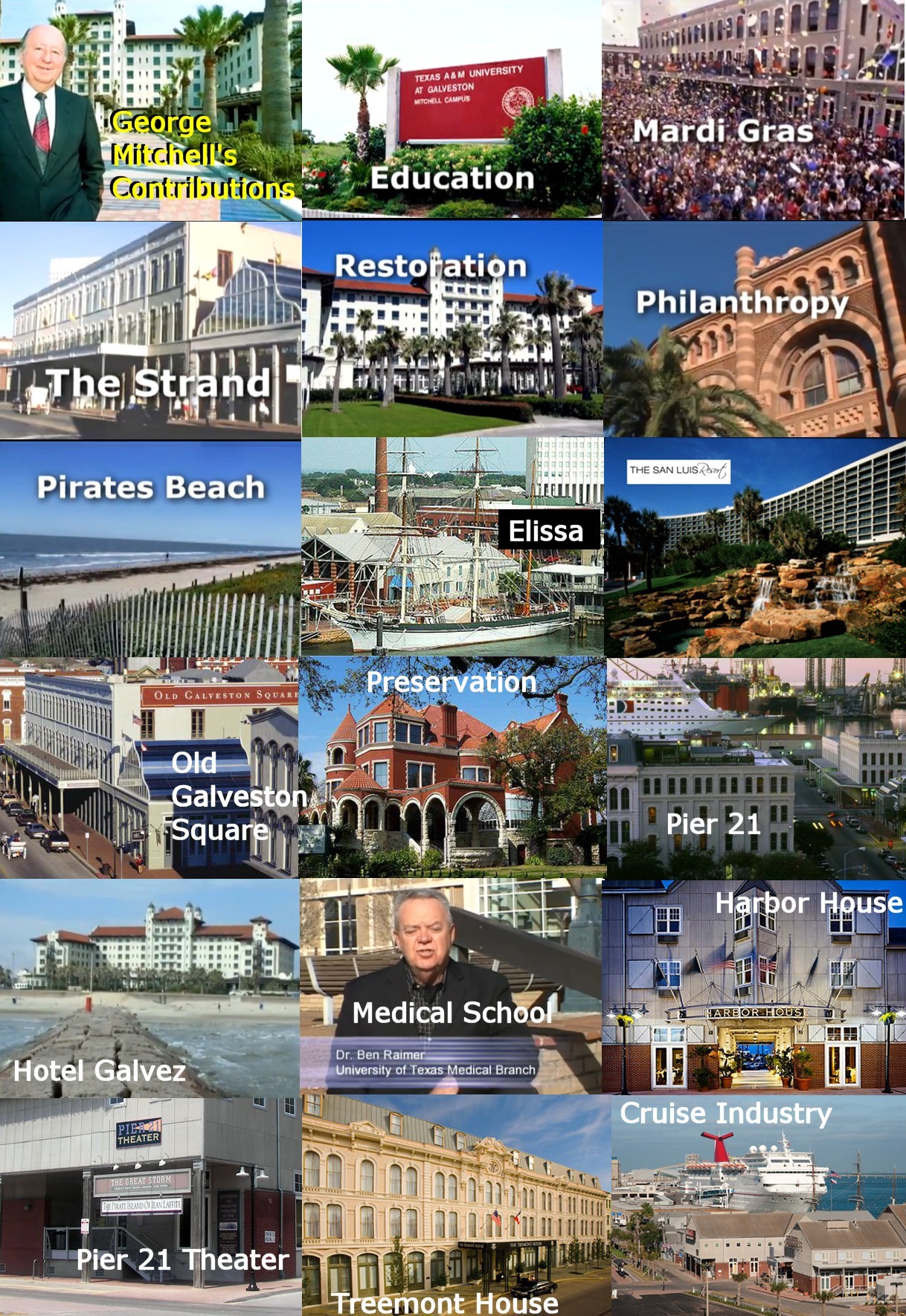
|
|
SUBCHAPTER 108
-
THE RAGS TO
RICHES STORY OF GEORGE MITCHELL
Rick Archer's Note: Much of the
following
excerpt comes from an interview with George Mitchell
that can be found in Joseph Kutchin's book
How Mitchell Energy and Development Corp. Got Its
Start
|
George and Maria Mitchell's father was Savvas Paraskevopoulos, a
poor, uneducated man who migrated from Greece to
America.
Along the way, Paraskevopoulos acquired a
new name... Mike
Mitchell.
Savvas
Paraskevopoulos was born in Greece in 1881.
Paraskevopoulos could neither read nor write. As a
young man, Paraskevopoulos made a living as a goat
herder.
Seeking a better opportunity, Paraskevopoulos decided
the only way he could make something of his life was to
emigrate from his small mountain village of Nestani in
Greece to America.
Paraskevopoulos immigrated to the United States in 1901.
He was 20 when he
arrived at Ellis Island.
Paraskevopoulos was a strapping lad who soon got a job as a laborer on a railroad
gang. He gradually moved west which is where his
railroad job was taking him.
One day Paraskevopoulos was in Arkansas when he went to
his Irish foreman to collect his pay.
"What's your name, mister?" the foreman demanded.
Paraskevopoulos told him.
"Forget it. I can't say your name or imagine how to spell it," the foreman snapped. "Use
my name or I'm going to fire you."
"Okay, what's your name?" Paraskevopoulos asked.
"Mike Mitchell," the foreman said.
"Well," Paraskevopoulos said, "then that's my name too."
And with that, Paraskevopoulos traded his Greek name for an
Irish name.
Now known as
Mike Mitchell, Paraskevopoulos discovered his
cousin had recently arrived in America. The two of them
decided to meet in Houston. There they opened a shoeshine
stand near the Rice Hotel in the center of downtown Houston.
Mike
Mitchell would eventually leave Houston and settle in Galveston,
Texas. In Galveston, Mitchell ran a succession of
shoeshine shops. Soon he branched out into a
dry-cleaning shop that pressed and ironed shirts as well as
other clothes.
|
One day Mike Mitchell saw the picture of a beautiful
Greek woman in the local Greek newspaper. He was
immediately smitten. Only one problem - this
beautiful young lady lived in Florida. Mitchell
lived
in Texas.
Mike Mitchell was undeterred. Though still
scraping to get by -- a lifelong condition -- Mitchell
hopped on a train and headed for Florida. Mitchell
now traveled 1,000 miles for the sole purpose of asking
a woman who was a complete stranger to marry him.
When he got to Florida, Mitchell discovered his dream
woman, the stunning Katina Eleftheriou, was already
engaged to someone else.
Indeed, she had recently arrived from Argos, Greece, to
enter into a marriage arranged by her sister.
Mitchell took the news in stride.
Mike Mitchell wasn't the sort to quit easily. As
long as she wasn't married, Mitchell had a chance.
In fact, since the lady was marrying a complete stranger, she
probably had not formed any attachment yet.
Mitchell was a born hustler who knew how to
turn on the charm.
Mitchell told Katina that he had made it this far from
Greece to begin with and now he had come all the way
from Texas to see her. He added that he lived a
life of ease thanks to his many businesses.
Of course, with a thousand miles of separation, Mitchell
felt comfortable exaggerating the extent of his
fortune.
The young lady was impressed and quite flattered.
Dazzled by this confident Greek-American with his
beautifully tailored suit, ample supply of clean shirts
and fresh carnations in his lapel, Katina liked him a
lot better than the guy her sister had found for her.
Mike Mitchell had succeeded in sweeping the young lady
off her feet. Katina Eleftheriou broke off her
engagement to her first suitor, married Mike and moved
all the way to Galveston.
One has to wonder what the former Ms. Eleftheriou thought when she realized the new luxury home
Mitchell had promised her was actually a tiny apartment
above Mitchell's shoeshine shop. However, she must
have seen promise in her new husband because she stuck
around.
If nothing else, this Mitchell fellow was
aggressive. That he was.
Mike and Katina had four children.
The first three were boys - Johnny, Christie, George -
and then came Maria in 1920, the same year Prohibition
started.
Following the birth of Maria (i.e. Mrs. Ballantyne), the next
eleven years were full of happiness for the family. The
children's mother was quite warm and deeply concerned about
their fortunes.
Then in a flash, it was all gone. In 1932, misfortune hit.
That is when Katina Mitchell suffered a stroke.
The children's mother died soon after. It was
a terrible tragedy.
The two older boys,
Johnny and Christie, were old enough to take care of themselves, so
they got jobs. However their father decided he did not
have the means to take care of the two younger children.
Mike Mitchell farmed his son George out to his brother and sent Maria over to
live with
his sister.
|
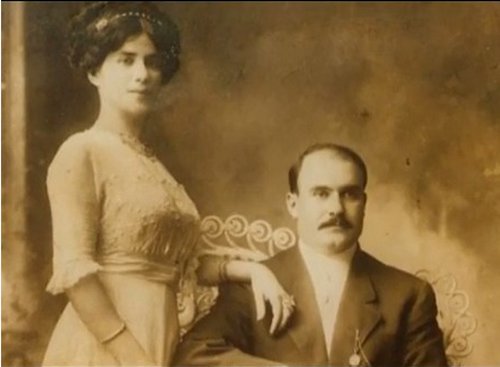
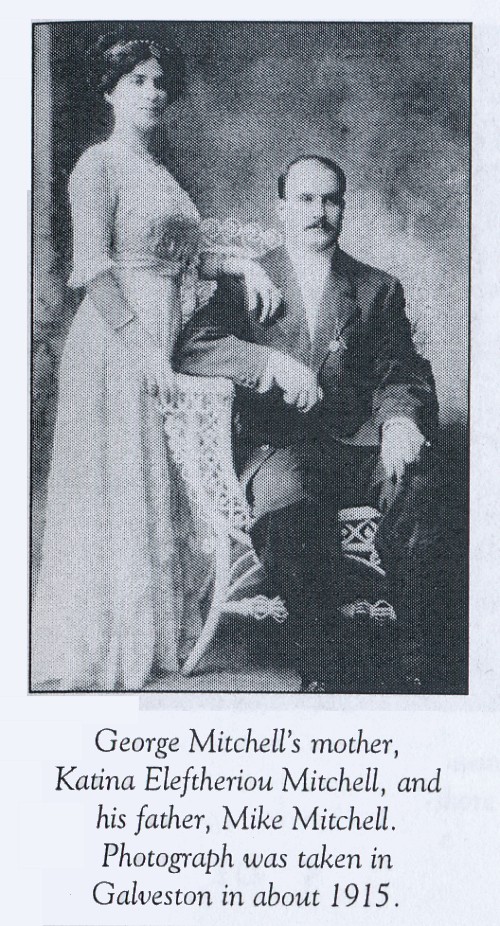 |
An outstanding student, George Mitchell finished high school in
Galveston at 16.
No college would accept him at that age, so Mitchell went to
another high school for a year and brushed up on math.
George's mother had long hoped her smart son would become a
doctor, but George Mitchell's interests went elsewhere.
Although his first love was astronomy, he decided oil offered
the most promise as a career.
In
1935, the following year, George Mitchell was accepted into Texas A&M, a school
with a strong petrochemical engineering program.
Texas A&M was located in College Station 130 miles northwest of
Galveston. Lacking a car, Mitchell was completely on
his own on the A&M campus. There was no support system waiting for
him at school and no trips home to cheer him up.
Furthermore George Mitchell had only the money he made
selling fish he caught back in Galveston. His father was
too busy losing money at poker to provide any help. Consequently
George was constantly forced to scramble for
tuition and living expense money. His problem was intensified by a hard and
fast A&M rule... non-payment of tuition meant automatic
expulsion. As a school based on military principles,
A&M took a hard line where tuition was concerned.
Tuition in those days was $39 a month. A student was given
45 days after the bill was due to pay up. After
that, it was time to go. No exceptions.
George Mitchell may have been virtually penniless when he set foot on the
A&M campus, but he wasn't going to let that stop him.
George Mitchell had incredible drive. Although he was short on cash,
George was long on determination.
Forced to work a neverending succession of part-time jobs, one
day Mitchell had an interesting idea. Since A&M was a
men's college, the campus was full of lonely boys who missed
their hometown honeys. Mitchell decided to sell
gold-embossed stationery for the lonesome male students to mail
to their sweethearts back home or take with them on their next
visit. The item sold like hotcakes.
However, this clever idea was hardly sufficient to pay his way
through college.
Mitchell was nearly kicked out of
college several times because he couldn't pay the $39 he needed
each month to cover tuition plus the extra $10-$15 needed for
room, board and school books. Working practically
non-stop, Mitchell would sell candy, wait tables and build
bookcases... anything to make money. Sometimes when he was
short, Mitchell would borrow the rest from a friend and pay him back
later. Mitchell did whatever it took to make the
monthly payment so he could continue his studies.
Unfortunately, the day finally came when no matter how hard he
tried, Mitchell
could not scrape enough money together. This seemed like
the end of the line. George grimly faced the fact that unless
he could think of something, he would be forced to drop out of
school.
Desperate, the young man thought about asking his father for
help. This was a move George dreaded making. For one
thing, it was a long shot. Depending how the poker cards
had been falling, half the time his father was penniless.
More
important, Mitchell's pride prevented him from asking his
unreliable father for anything. However, now that it
was beg or leave school, George swallowed his pride and wired
his father for money.
In
George Mitchell's own words...
"As I expected, at the time Dad
wrote back that he didn't have a cent to his name.
So my dad said he would ask Sam Maceo, the Godfather of
Galveston, if he would help.
My
father said, 'Mr. Maceo, sir, my
son is the top student at A&M,
but he is going to get kicked
out because he doesn't have any
money.
Do you think you can you help him?' "
Sam
Maceo, the famous Galveston gambling
impresario known for his generosity,
smiled. On the spot, Maceo
reached into his pocket and handed
the elder Mitchell a hundred dollar
bill.
"Thinking fast, Dad immediately
got change and broke the bill in
two. He knew I only needed
$50, so he sent me $50 and kept
the other $50 to play poker.
My father always lived by his
wits."
That was the lucky break George
needed. Thanks to this
contribution and several more timely Maceo
contributions along the way, George
would make his monthly college
payments on time for the rest of his
tenure at A&M.
There was a special reason Sam Maceo
continued to help. The
Godfather had checked on George's
grades at Texas A&M. Mike Mitchell
was a
notorious embellisher. Sensing
a possible scam, Maceo called A&M.
To his surprise, Mike Mitchell had
been telling the truth. The
register reported that George was
currently at the top of his class.
Maceo was impressed. From that point on,
Maceo made sure
George would no longer have to
worry about money.
George Mitchell was indeed an
excellent student. He finished
first in his A&M class in petroleum
engineering. He became a
battalion commander in the Aggie
Corps of Cadets. Mitchell even found
time in addition to his studies and all his odd jobs
to become captain of the A&M tennis
team.
|
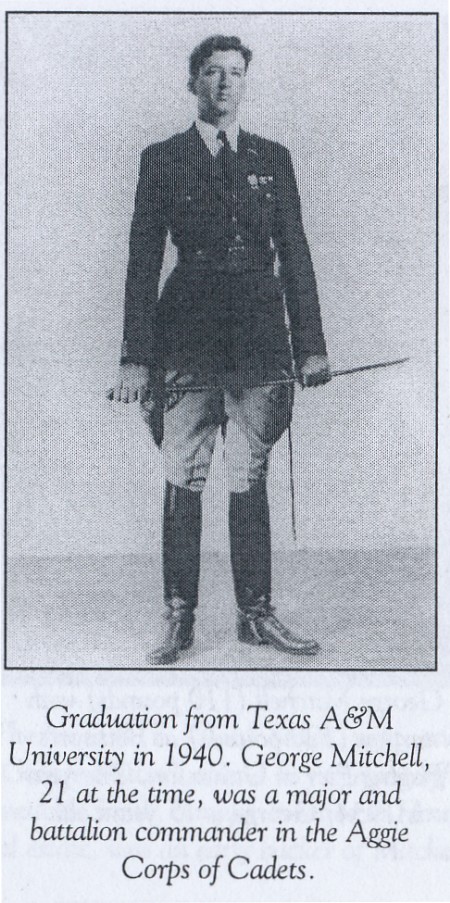 |
|
|
|
George Mitchell may have graduated first in
his class, but he also graduated without a
cent to his name. Not a problem.
Once Mitchell had his education, he would go
on to become an extremely successful oilman.
Mitchell had such a legendary career. As the founder of
Mitchell Energy and Development, Mitchell became a giant in
his field. His major accomplishment was pioneering the
economic extraction of shale gas, better known as fracking.
George Mitchell is credited with creating the modern shale
revolution which in turn freed America from its over-dependence on
Arab oil.
One of Mitchell's major accomplishments was
building The Woodlands, a
planned community north of Houston placed in
a pine forest. Referred to as 'The
City of Tomorrow', Mitchell demonstrated how
civilization and nature could be combined if
humans were willing to use sufficient
imagination.
Forbes Magazine
ranked George Mitchell the 249th richest American in 2013.
|
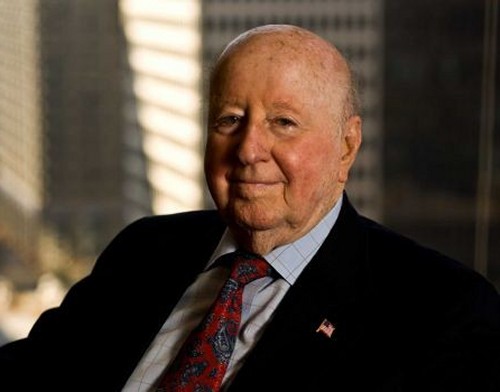 |
“George Mitchell is the father of fracking.
Mitchell's
fracking technique is
by far the most
important energy
innovation of this century.
It is because of George Mitchell that today we
are able to talk seriously about ‘energy
independence’ here in the United States."
-- Daniel Yergin,
oil-industry historian
|
“Mr. Mitchell’s role in championing new drilling and production
techniques like hydraulic fracturing is
credited with creating an unexpected natural gas boom in the
United States."
-- New York Times
|
|
Despite his riches,
George Mitchell remained a humble man who never forgot his roots.
Crediting his fine education at A&M for
giving him the knowledge he needed to become
successful, Mitchell would go on to donate $400
million to the university.
Mitchell loved A&M fiercely. An Aggie
to the core, Mitchell took great pride in helping students
who were poor like he had been get an education there. Who would
have ever thought that George Mitchell, the
boy who could barely pay his tuition, would one day become
the largest donor in Texas A&M history?
It was unbelievable what George
Mitchell accomplished in Galveston.
With
the help of his talented wife Cynthia,
Mitchell literally put the entire city on his
shoulders and breathed economic life back
into Galveston. Furthermore, Mitchell
created an economy based on jobs that were meant to
stay.
Houston may have had Jesse Jones, but
Galveston had George Mitchell.
Mitchell was a visionary
who saw the value of saving what had
been built in the 19th Century.
He turned preservation and
renovation into
a city-wide ethos.
The Galveston of today is a thriving gem
complete with stylish restored hotels,
beautiful beaches, magnificent Victorian
homes and renovated buildings downtown.
Galveston is fast becoming the tourist mecca
Houston only wished it could be.
George Mitchell never forgot the
kindness of the man who had helped him stay
in school during the toughest stretch of his
life. I firmly believe that Sam Maceo's gesture affected Mitchell in a
profound way.
To me, there is powerful symbolism here.
How incredible is it that Sam Maceo, the man
who was once the savior of Galveston, would
coincidentally hand the baton to George
Mitchell, his eventual successor, through
his
simple act of kindness?
I have to wonder if George Mitchell was
just as aware of the symbolism as I am.
Since George Mitchell spoke of Sam Maceo's
gesture on many occasions, there cannot be
any doubt that what Maceo did left a powerful
impression. I believe George Mitchell
sensed that Sam Maceo had touched him
in some way.
Amazed that the Godfather of Galveston would
go out of his way to help some nameless kid,
George Mitchell chose to pay the kindness
forward. Mitchell made sure that
Galveston, a city mired in thirty years of
hardship, got back on its feet.
|
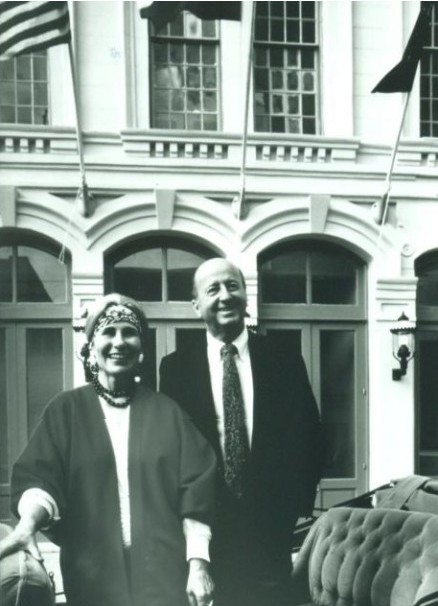
Cynthia and George Mitchell
at theTremont Hotel.
After the renovations were complete, the
place looked
so nice that even the ghosts returned.
|
|
|
|